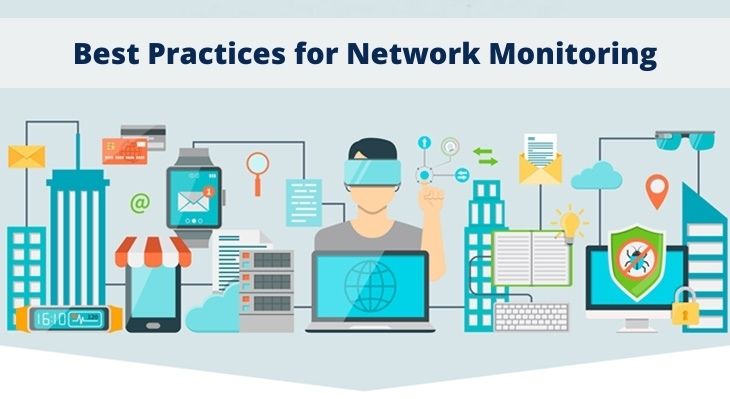One of the best ways to ensure the smooth functioning of corporate networks is through constant monitoring of the resources of the infrastructure used for the connection between computers.
Your network architecture is the backbone of your infrastructure, it allows the routing of data and internal and external users to access services.
Network monitoring is essential to ensure that there are no issues accessing services and that no failures occur.
Most organizations believe that, with the simple purchase and configuration of monitoring tools, the network will be saved from connection and speed problems.
With a good management plan, technical professionals will be able to correctly verify all the nuances that are necessary for the proper functioning of a network structure.
Here are the Best Practices for Network Monitoring
The adoption of best practices for network monitoring is fundamental for tracking faults and problems that, eventually, can cause remote services to be unavailable.
Without a complete view of the network infrastructure, you will not be able to monitor it properly.
To save you the trouble of having to manually collect this information, network monitoring software can automatically create reports in minutes.
As soon as you have an up-to-date network map, you can ensure that each piece of equipment is positioned and configured optimally.
Having monitoring programs with a simple interface is another practice.
There are tools that present performance graphs that evaluate the state of network elements and programs.
A network analysis tool helps you optimize your network infrastructure and increase your network’s efficiency by identifying the use of bandwidth and resources.
Moreover, network monitoring solutions optimize for maximum coverage by monitoring compute, network, storage, VoIP, wireless, and more. They have a panoramic view of the infrastructure.
Also Discover: 8 steps to prevent your emails from spoofing
It is from this analysis that technology experts are able to define the next investments, evaluate the business performance, and also avoid invasions and boycotts, that can put your organization at risk.
Through monitoring, it is possible to assess how the system is behaving during use.
Before putting the monitoring into practice, however, it is necessary to correctly size the system to find out if the resources are adequate for the company’s demand.
If the network becomes overloaded, the quality of access to services will be affected, as will the reliability of the system.
Another interesting practice is to do network monitoring in an automated way, since it allows those responsible for IT to be informed about failures in real-time, reducing the time taken to solve cases.
In this process, the cost of maintenance falls, as it prevents the network from operating at the limit of its capacity and wears out its components.
Organizing the equipment involved, the resources available, and the accesses released by employees from all sectors are just a few steps to be taken by those looking to manage the network.
A good way to do this is by creating an inventory. It should contain everything that will be managed – either manually or using technology.
Good network management cannot be done if analysts do not know what equipment is involved in accessing company resources.
Therefore, it is necessary to maintain an inventory of all equipment and systems that will be managed by the IT team.
Simple Network Management Protocol (SNMP) is another best practice for network monitoring. It is one of the widely accepted protocols for managing and monitoring network elements.
Belonging to the application layer allows the exchange of extensive information on the different network devices.
Its basic function is to facilitate the exchange of management information between devices on the network.
Being able to configure SNMP on a single page simplifies the process of adding new or reimaged appliances or appliance clusters to your network.
This protocol can provide you with information about the CPU and memory usage of various devices, graphs with traffic statistics & the number of processes running on a specific device.
To ensure the optimization of resources, devices must be configured to suit the demands of each environment.
IP, firewall, and DNS parameters must be modified so that the sending and receiving of information occurs in the best possible way.
Although this activity is time-consuming for network analysts, it avoids a series of long-term problems.
Once the network is configured, operating standards must be established by the team responsible for the company’s digital equipment.
They will assist technicians and analysts to identify points for improvement, flaws, and vulnerabilities.
Alerts are only useful if they come at the right time, for the right reason.
You want to know when you have a network problem to solve but not receive false alerts or see your email box full of alarm messages.
Simplify your network monitoring by configuring only the notifications you need. Create alerts that will allow you to react quickly to resolve issues.
Also, make sure you have a clear escalation plan, everyone on your team needs to know who will receive alerts, under what circumstances, and what to do.
This is the only way to ensure that alerts will be handled effectively and will prevent serious network disruption. This is all the more important if you have to meet SLAs.
Conclusion
In addition to all the investments that must be made in infrastructure, new technologies, security, monitoring is an action that can never leave the radar of companies that want to remain competitive in their markets.
You may also like to read: Top 11 Network Configuration Management Tools

